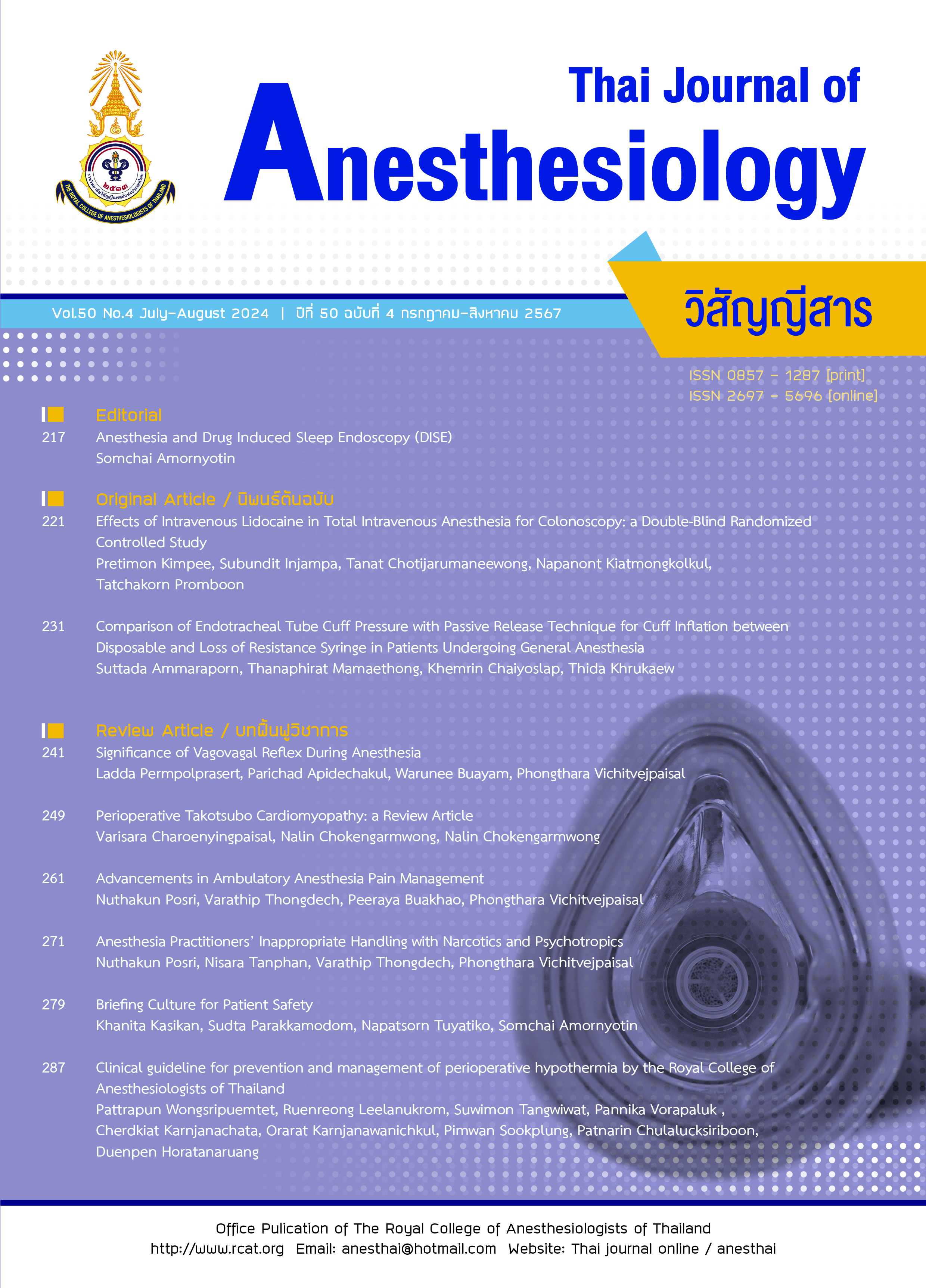Comparison of Endotracheal Tube Cuff Pressure with Passive Release Technique for Cuff Inflation between Disposable and Loss of Resistance Syringe in Patients Undergoing General Anesthesia
Main Article Content
Abstract
Background: The standard technique to maintain optimal endotracheal tube cuff pressure is the manometer, but it is not always available. Passive release technique has been shown in previous studies to be one of the most accurate alternative methods to provide cuff pressure within an optimal range (20-30 cmH2O). The objective of the study is to compare endotracheal tube cuff pressure in patients undergoing general anesthesia by inflating the endotracheal cuff with passive release technique between two types of syringes; disposable and loss of resistance syringes. Methods: A prospective double-blinded randomized control study was conducted in Rajavithi Hospital, enrolling patients undergoing elective surgery under general anesthesia with endotracheal tube. Cuff pressure after passive release technique was measured. If cuff pressure was less than 20 cmH2O, air inflation was done until it reached 20 cmH2O. If cuff pressure exceeded 30 cmH2O, air deflation was done until it reached 25 cmH2O. Results: One hundred patients were randomized to the disposable syringe and loss of resistance syringe group, with fifty patients in each group. Mean cuff pressure after passive release technique was 29.24±6.02 cmH2O in the disposable syringe group which was statistically significantly different from the loss of resistance syringe group (19.24±6.27 cmH2O). There were 23 patients (46%) in the disposable syringe group and 15 patients (30%) in the loss of resistance group with cuff pressure within an optimal range. Conclusion: The disposable syringe group was superior to the loss of resistance syringe group in providing cuff pressure within an optimal range.
Article Details

This work is licensed under a Creative Commons Attribution-NonCommercial-NoDerivatives 4.0 International License.
References
Yildirim ZB, Uzunkoy A, Cigdem A, Ganidagli S, Ozgonul A. Changes in cuff pressure of endotracheal tube during laparoscopic and open abdominal surgery. Surg Endosc. 2012;26:398-401.
Suzuki N, Kooguchi K, Mizobe T, Hirose M, Takano Y, Tanaka Y. Postoperative hoarseness and sore throat after tracheal intubation: effect of a low intracuff pressure of endotracheal tube and the usefulness of cuff pressure indicator. Masui. 1999;48:1091-5.
Lui J, Zhang X, Gong W, et al. Correlations between controlled endotracheal tube cuff pressure and postprocedural complication: a multicenter study. Anesth Analg. 2010;111:1133-7.
Mohammed SH, Shawer OAEG, Mohammed MA, Mohammed OA. Relation between endotracheal tube cuff pressure measurements and the incidence of ventilator associated pneumonia. Assiut Scientific Nurs J. 2021;9:140-8.
Kumar CM, Seet E, Van Zundert TCRV. Measuring endotracheal tube intracuff pressure: no room for complacency. J Clin Monit Comput. 2021;35:3-10.
Sultan P, Carvalho B, Rose BO, Cregg R. Endotracheal tube cuff pressure monitoring: a review of the evidence. J Perioper Pract. 2011;21:379-86.
Bulamba F, Kintu A, Ayupo N, et al. Achieving the recommended endotracheal tube cuff pressure: a randomized control study comparing loss of resistance syringe to pilot balloon palpation. Anesthesiol Res Pract. 2017;2017:2032748.
Laksono BH, Isngadi I, Wicaksono SJ. Passive release technique produces the most accurate endotracheal tube cuff pressure than manual palpation and minimum occlusive volume technique in the absence of manometer. Turk J Anaesthesiol Reanim. 2021;49:114-7.
Gilliland L, Perrie H, Scribante J. Endotracheal tube cuff pressures in adult patients undergoing general anaesthesia in two Johannesburg academic hospitals. South Afr J Anaesth Analg. 2015;21:81-4.
Kim HM, No JK, Cho YS, Kim HJ. Application of a loss of resistance syringe for obtaining the adequate cuff pressures of endotracheal intubated patients in an emergency department. J Korean Soc Emerg Med. 2012;23:769-75.
Huh J, Yoon TG, Kwon WK, Joo Y, Kim DK. Usefulness of new technique using a disposable syringe for endotracheal tube cuff inflation. Korean J Anesthesiol. 2009;56:513-8.
Tsaousi GG, Pourzitaki C, Chlorou D, Papapostolou K, Vasilakos D. Benchmarking the applicability of four methods of endotracheal tube cuff inflation for optimal sealing: a randomized trial. J Perianesth Nurs. 2018;33:129-37.
Mamta D, Amit Km, Manish C. Loss of resistance syringe: a substitute for cuff pressure manometer. Anesth Analg. 2017;125:701-3.
Ahmad A, Salahu D, Mamuda A, Adesope S, Usman N. Achieving an optimal endotracheal tube pressure: comparison of loss of resistance and pilot balloon techniques. Borno Med J. 2022;19:6-11.
Park HY, Kim M, In J. Does the minimal occlusive volume technique provide adequate endotracheal tube cuff pressure to prevent air leakage?: a prospective, randomized, crossover clinical study. Anesth Pain Med (Seoul). 2020;15:365-70.
Mamuda A, Ahmad A, Salahu D. Minimizing adverse effects of subjective measurement of endotracheal tube cuff pressure: can the use of the loss resistance technique help? Ibom Med J. 2023;16:56-61.

